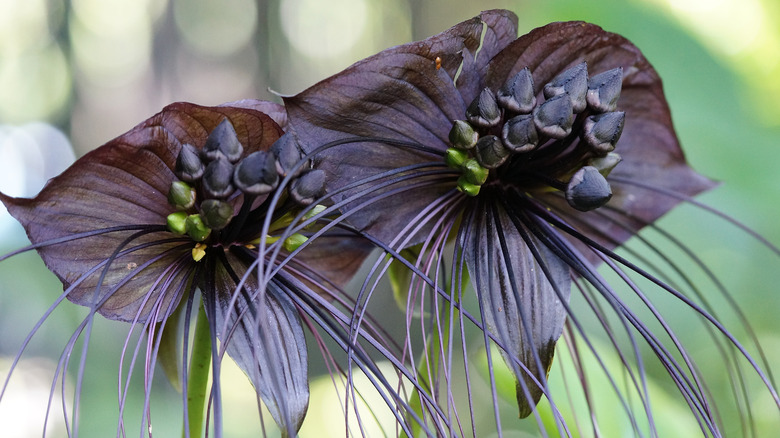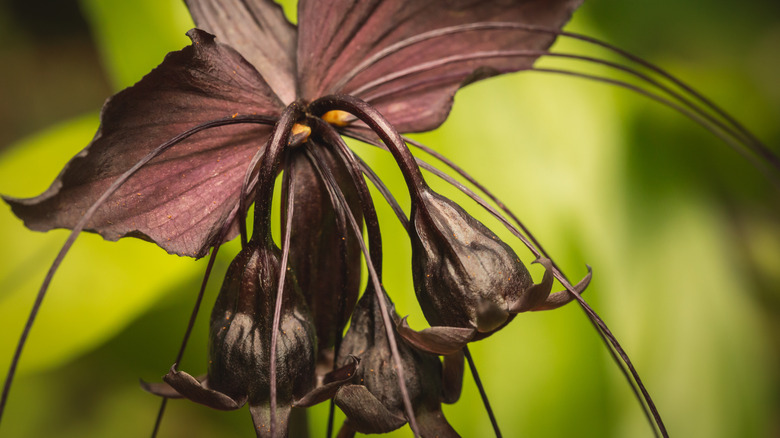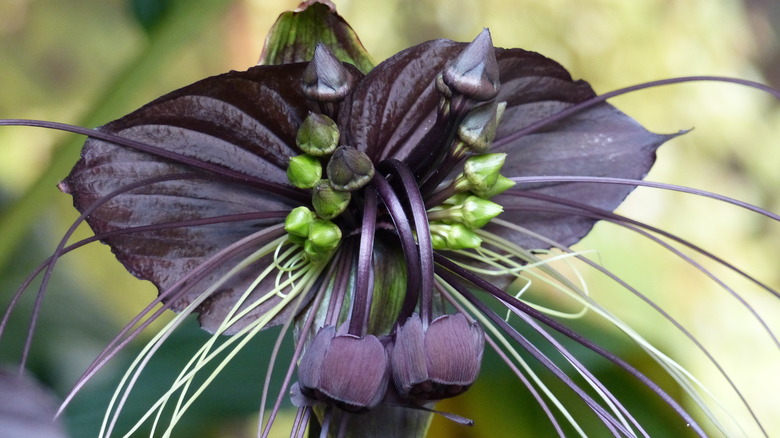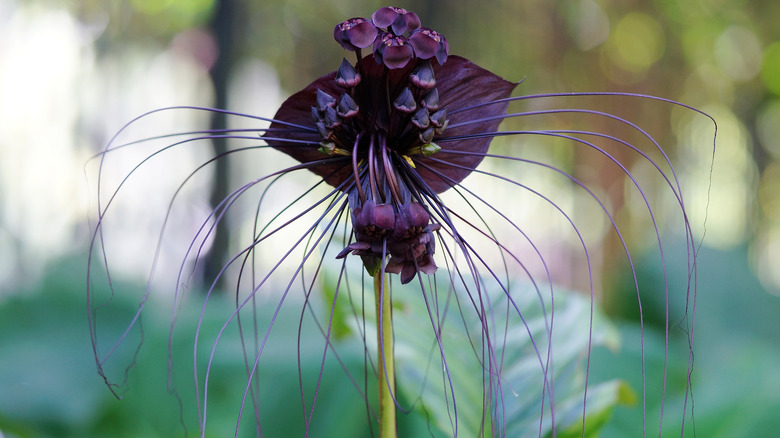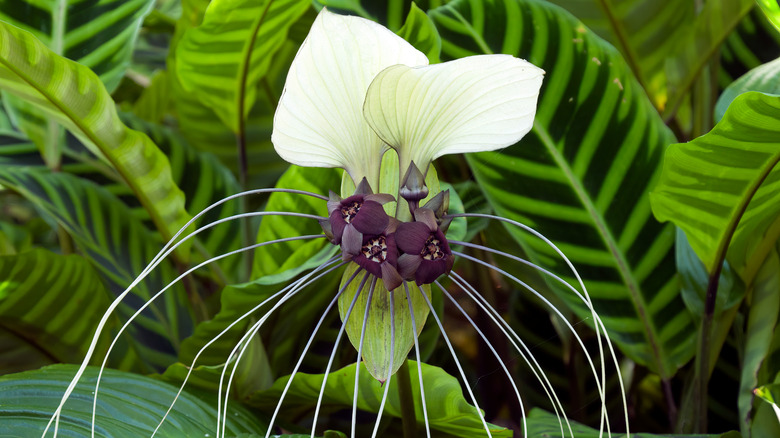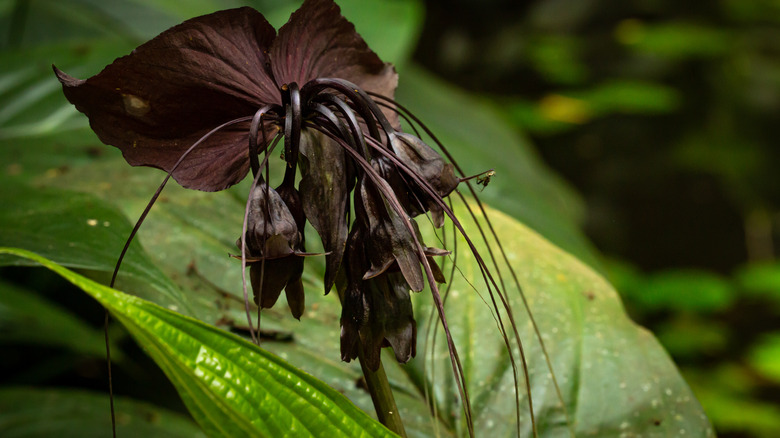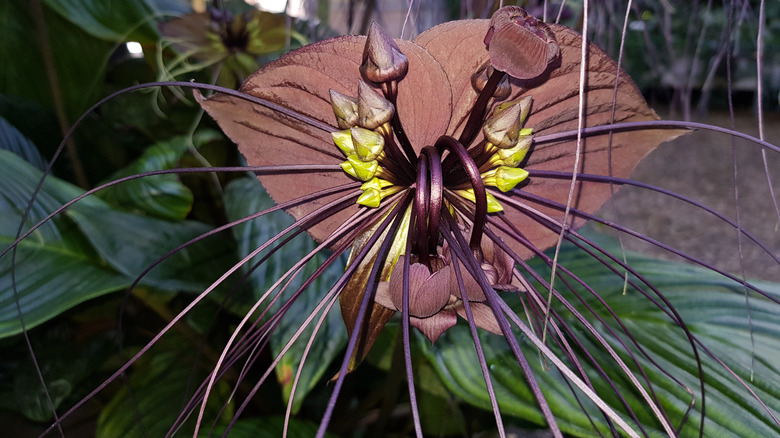How To Care For A Black Bat Flower
The black bat flower (tacca chantrieri), also known as tiger beard or cat's whiskers, according to The Spruce, is a plant with deep purple, almost black flowers, resembling the pigmentation and shape of a bat. Its other nicknames come from the long, spindly bracteoles resembling cat whiskers. New blooms grow from buds that form in the center of the flower, which will cluster before blooming, almost resembling spidery eyes, and then bloom in a drooping shape.
Black bat flowers are quite visually stunning, with a dramatic, gothic air. These perennials tend to bloom late spring through early fall, perfect for a haunting garden during the months leading up to Halloween. They can grow up to three feet tall and grow best in warmer climates, being native to Southeast Asia and Australia.
This hauntingly beautiful flower is not well suited for floral arrangements but can easily be grown in any garden or house given the right conditions, whether natural or manufactured. If you would like to learn more about caring for these mysterious-looking plants, keep reading.
How to use black bat flowers in garden
Black bat flowers are an entirely decorative plant and can add a very unique touch to your garden. Whether featuring it amongst contrastingly delicate or understated flowers or displaying an array of the flowers in a garden that would be the envy of Dracula himself, they are a great choice for creating a dramatic and almost gothic look.
Black bat flowers are not the only black (technically purple) flower there is, though. For those looking to make their backyard a truly gothic paradise, Balcony Garden Web suggested a few other black flowers, such as the queen of night tulip, blackberry petunia, before the storm iris, and the black baccara rose, just to name a few.
The tacca chantrieri is also a relative of the orchid, according to Gardening Know How, and can be used in conjunction with other orchids and other orchid companion plants. Outdoor orchids are usually grown in conjunction with tropical foliage plants, according to Chadwick Orchids, such as rubber trees, banana palms, and philodendrons. The bright green leaves of these plants complement the gentle orchid but will provide a stark and show-stopping contrast with the mystical purple hues in the black bat flower.
How to grow black bat flowers
There are a variety of ways to grow black bat flowers. As with almost any flower, the easiest way to grow them is to look for flower bulbs, which can easily be put in the ground and will root and bloom quickly thereafter (when compared to seed growth). Black bat flowers are semi-rare, however, and you may have issues both finding them from a reliable in-person or online seller or find that they're too expensive.
They can also be grown from seed. While this is one of the easier to obtain and more economically friendly options, Plant Care Today warned that this method is difficult and requires a lot of patience, and relies on waiting for an existing plant to mature fully and then produce seeds.
The other method to produce more black bat flowers is via propagating the roots. Black bat flowers have rhizomes, which is a root system shared by vegetables such as ginger and turmeric. In the fall just before dormancy, uproot your plant and very gently separate the tuberous roots from one another. Separate them either three feet apart, or in separate pots, following basic repotting protocol. Make sure to nurture heavily at this stage, ensuring the roots take to their new home and the plant produces flowers.
How to care for black bat flowers
Black bat flowers are a subtropical plant; this black variety of the tacca genus specifically originated from Malaysia, according to Plant Care Today. For year-round outdoor growth, you should ensure you are located with USDA hardiness zones 9b to 11. Black bat flowers can also be uprooted and moved inside for their dormant months or grown in containers for easy transportation between the seasons. They can also be grown indoors year-round. Never expose them to temperatures below 60 degrees.
As for light, these flowers need shade with indirect light. Indoors, this can be an eastern or western window outside of direct morning or evening rays or a northern window. Avoid southern windows. Outdoors, consider planting them under an awning or a larger tree or bush. They also like to be very humid, preferring around 50% humidity. If your climate is not humid enough, consider frequent misting, a pebble tray, or a plant humidifier.
Black bat flowers prefer to be consistently moist but not soggy, which can lead to infection and root rot. Plant Care Today also recommended bottom watering, but be careful not to let them sit in standing water for too long, which can also cause root rot. Fertilize every couple of weeks during the growing season with a liquid fertilizer diluted to 1/3 strength.
Black bat flower varieties
The black bat flower is a part of the tacca genus. According to Insteading, there are roughly 15 species within this genus, with tacca chantrieri, the black bat flower, being the most popular. The other varieties are quite rare and hard to identify, and very uncommon to come across in North American gardening circles, but still very interesting. A few of these varieties include:
-
Tacca integrifolia — This is the white bat flower, which looks and functions exactly like the chantrieri species but white, with dark purple buds in the center of the flower.
-
Tacca palmatifida — Native to the Sulawesi island in Indonesia, very little is actually documented about this species. There are a few pictures from Vertical Garden, though, and are identifiable by the large green fronds that form an almost spade-like shape.
-
Tacca leontopetaloides — Known also as Polynesian arrowroot, this species of tacca is green to brown with larger round bulbs, and the starch-rich tubers are often turned into flour used for soups and breads, according to Plants for a Future.
Are black bat flowers toxic?
There is not much documentation on the toxicity levels of the tacca genus and is not listed on the ASPCA list of toxic and non-toxic plants. For this reason, it is generally a good and precautionary idea to keep children and pets away from black bat flowers. If you suspect your child or pet has ingested the plant, call their primary physician or vet and monitor any shifts in behavior, mood, or health.
That being said, there are some homesteading uses for this plant, which are to be followed at your own discretion. According to Insteading, for example, herbalists have been known to use this flower for things such as digestive issues, diarrhea, dysentery, internal bleeding, and inflammation and swelling. The plant also contains a variety of vitamins and nutrients, such as calcium, iron, riboflavin, protein, and starch. These nutrients can be found in safer settings from other plants, vitamins, and foods, though. Insteading also warns against those who are pregnant or breastfeeding from ingesting this flower.
How to repot black bat flowers
Growing black bat flowers in a pot is a great idea for those wanting to either bring them indoors during dormancy or those wanting to keep them indoors as houseplants. That does mean you will have to occasionally repot them, though. According to The Spruce, black bat flowers benefit from annual repotting, as they do not like being root-bound. They recommend sizing up a pot per each repotting, specifically in a wide and shallow pot.
As for the potting mix, Plant Care Today recommended a rich and very well-draining soil. If buying a premixed potting soil, they suggest one that is 50% soil, 40% percent soil supplements (compost, perlite, pine bark, or peat moss) for additional nutrients, and 10% sand for increased drainage and a lesser chance of root rot. If you cannot find a potting mix to your liking, you can also easily recreate this yourself with the same measurements.
